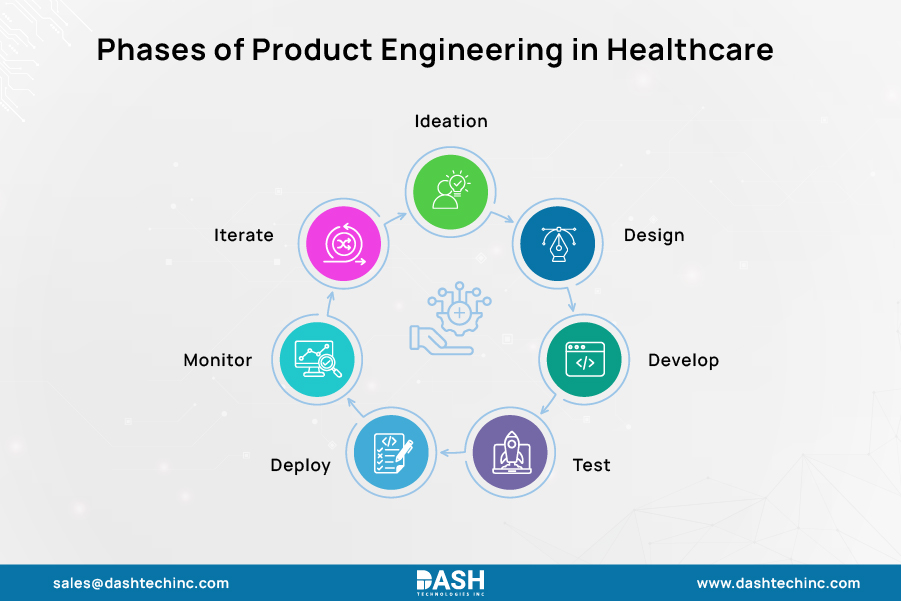The Role of Product Engineering Services in Healthcare Tech
The healthcare industry is at a turning point, with increasing costs, additional patient demands, and coping with the burden of chronic diseases. Traditional healthcare methods fail to meet current needs, which requires a foundational change in solution development and implementation processes. Product engineering represents a transformative force within this context.
Product engineering is more than just software development; it is a holistic, strategic discipline focused on creating innovative, user-centric, and market-relevant solutions that address these pressing challenges. This article from Dash Technologies explores how software product engineering isn’t only enhancing existing solutions but also shaping the future of healthcare technology.
Understanding Healthcare Product Engineering
Healthcare product engineering involves a considerable change from conventional software development to an end-to-end strategy that covers the entire product life cycle. It involves all the phases, like generating new ideas, designing, developing, testing, and deployment of software and hardware intended for medical use. Unlike conventional software engineering, which primarily focuses on technical aspects, software device engineering encompasses a broader perspective that considers market trends, user behavior, regulations, legislation, and clinical processes.
Key Areas Where Product Engineering is Transforming Healthcare

Electronic Health Records and Care Coordination
Modern software product engineering services bring transformative changes to both electronic health record (EHR) systems and care coordination platforms. Current healthcare organizations require advanced systems that enhance clinical operations, facilitate better data sharing, and enable more effective care management among various healthcare providers. The integration of advanced technologies like HL7 FHIR standards within these systems enables seamless data exchange, which helps reduce administrative tasks for healthcare providers.
Product engineering services transform Electronic Medical Record (EMR) systems to develop user-friendly interfaces that help reduce physician burnout and enhance data accuracy and accessibility. The provided solutions feature intelligent workflows that guide healthcare providers through clinical procedures, maintaining efficiency and ensuring adherence to best practice standards and regulatory mandates.
AI and Machine Learning Integration
The integration of artificial intelligence and machine learning solutions into healthcare systems occurs smoothly through advanced product engineering methods. The technologies deliver enhanced functions, including predictive analytics capabilities, automated diagnosis systems, and personalized treatment recommendations.
The development of AI-powered medical imaging solutions showcases the revolutionary capabilities enabled by healthcare product engineering. These sophisticated systems are able to detect tumors and other abnormalities more precisely and at higher rates than current methods, greatly improving diagnostic quality and patient outcomes. For instance, Google AI imaging technologies can assist physicians in diagnosing breast cancer through deep learning analysis of mammogram images.
Voice assistant tech and natural language processing are making their way into healthcare systems. This allows for hands-free use, making it easier for both doctors and patients, and improving accessibility. These technologies show how software product engineering services streamline healthcare interfaces and make them more user-friendly.
IoT and Connected Health Solutions
The Internet of Things has revolutionized healthcare with innovative product engineering, bridging the gap between devices, patients, and healthcare practitioners. IoT devices enable healthcare professionals to remotely monitor patient health metrics and vital signs in real-time from any location.
IoT applications for remote healthcare assistance enable doctors to monitor patients from anywhere in the world, providing critical health information and facilitating remote monitoring functions. Connected health solutions deliver essential healthcare solutions to underserved regions by providing equal access to quality medical services, regardless of patients’ location. This significant enhancement demonstrates how engineered healthcare technologies can save human lives.
Digital Therapeutics (DTx)
Digital Therapeutics (DTx) are a specific subclass of Software as a Medical Device (SaMD), which deliver evidence-based therapeutic interventions directly to patients. Software device engineering is a crucial skill in developing stand-alone software products, such as mobile apps, cloud-based software, or even desktop applications, each designed to achieve a specific medical outcome.
Their influence is significant: Digital therapeutics are designed to cure or alleviate different diseases by establishing and disseminating medical therapies through the prescription of clinical experts or confirmation of a diagnosis. Their use is expanding rapidly across a broad spectrum of conditions, including chronic diseases, mental disorders, metabolic disorders, neurological disorders, and substance use disorders.
Robotic Surgery and Advanced Interventional Systems
Product engineering is crucial to the development of robotic surgery systems, as it creates and improves software and hardware solutions that incorporate ongoing enhancements, such as haptic feedback technology and improved imaging capabilities. The use of robots in operating rooms continues to expand because of their proven effectiveness, combined with new financing approaches, resulting in broader access to healthcare facilities.
Advanced robotic systems enable surgeons to perform complex, minimally invasive procedures with unparalleled precision, resulting in an overall success rate of 94% to 100% for robot-assisted surgery. Patients can expect better recovery outcomes, with reduced recovery durations and surgical precision that reaches new high standards.
Build Faster. Scale Smarter. Lead Healthcare.
From early-stage ideation to post-launch support, our product engineering services help you build reliable, secure, and high-performing healthcare tech solutions that meet regulatory standards and patient needs.
Talk to Our ExpertsStages of Product Engineering in Healthcare
The process systematically converts a conceptual idea into a tangible product ready for the market. The approach typically involves the following stages:
- Concept Development: It starts with defining the purpose of the product, key features, and the target market. The first phase is most typically characterized by a lot of market research, brainstorming, and feasibility studies, followed by the formulation of detailed technical specifications to establish the viability of the concept.
- Design and Prototyping: The engineering team produces initial designs and functional prototypes following concept development. During this phase, engineers utilize CAD software, along with 3D modeling and rapid prototyping methods, to test product feasibility early and refine details before beginning full-scale development.
- Analysis and Simulation: Rigorous analysis and simulation processes evaluate products before they advance to mass production. The testing process ensures that products meet safety and functionality standards while complying with relevant industry regulations.
- Production Planning: This stage involves making cautious decisions about materials, manufacturing processes, and production methods to achieve performance goals within budgetary constraints.
- Testing, Verification, and Validation: Through thorough testing, engineers detect design flaws to ensure product reliability. The testing process involves ensuring that all specifications have been met and confirming that the product operates exactly as planned.
- Manufacturing and Deployment: This phase encompasses the actual production and subsequent release of the product to the market.
- Post-Launch Support and Optimization: Launch is merely the beginning. Engineers track product performance by analyzing data, along with customer feedback and field reports. The ongoing feedback cycle enables teams to pinpoint areas for improvement and supports the execution of updates in subsequent versions.
Software products typically follow a series of stages that include Requirement Analysis, Design, Development, Testing, Deployment, and Maintenance. Through this iterative cycle, products are launched and receive ongoing enhancements to meet changing demands.

Final Thoughts
Healthcare product software engineering thrives when medical professionals team up with engineers and designers, along with regulatory experts, to develop solutions that offer technological advancements while maintaining practicality and safety for both patients and healthcare providers. Dash Technologies leads the transformation by offering comprehensive product engineering services that connect healthcare needs with technological possibilities.
Reach out to Dash Technologies today to chat about your healthcare ideas and see how our services can transform those ideas into solutions that improve patient outcomes and drive business growth.
About Dash

Dash Technologies Inc.
We’re technology experts with a passion for bringing concepts to life. By leveraging a unique, consultative process and an agile development approach, we translate business challenges into technology solutions Get in touch.







